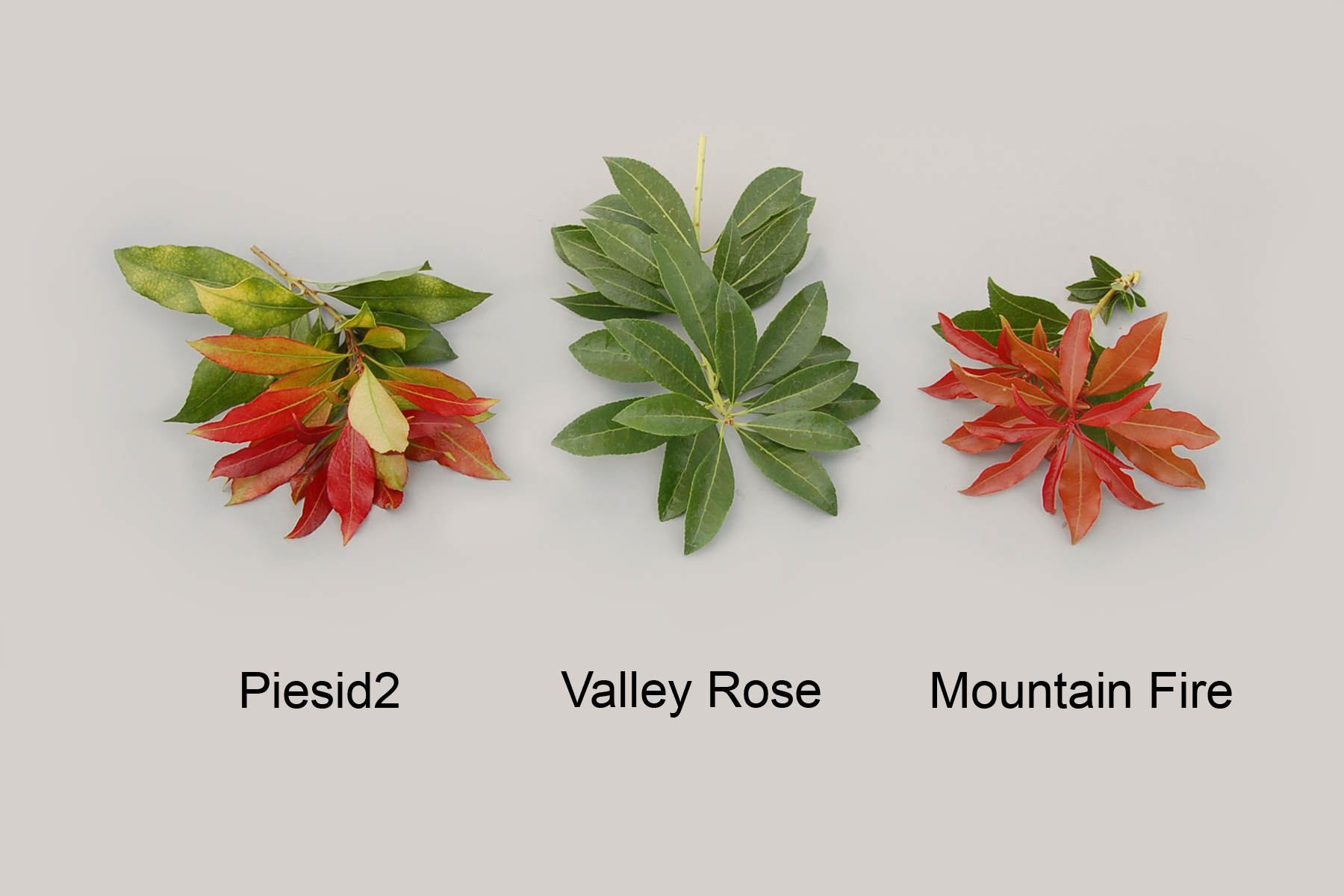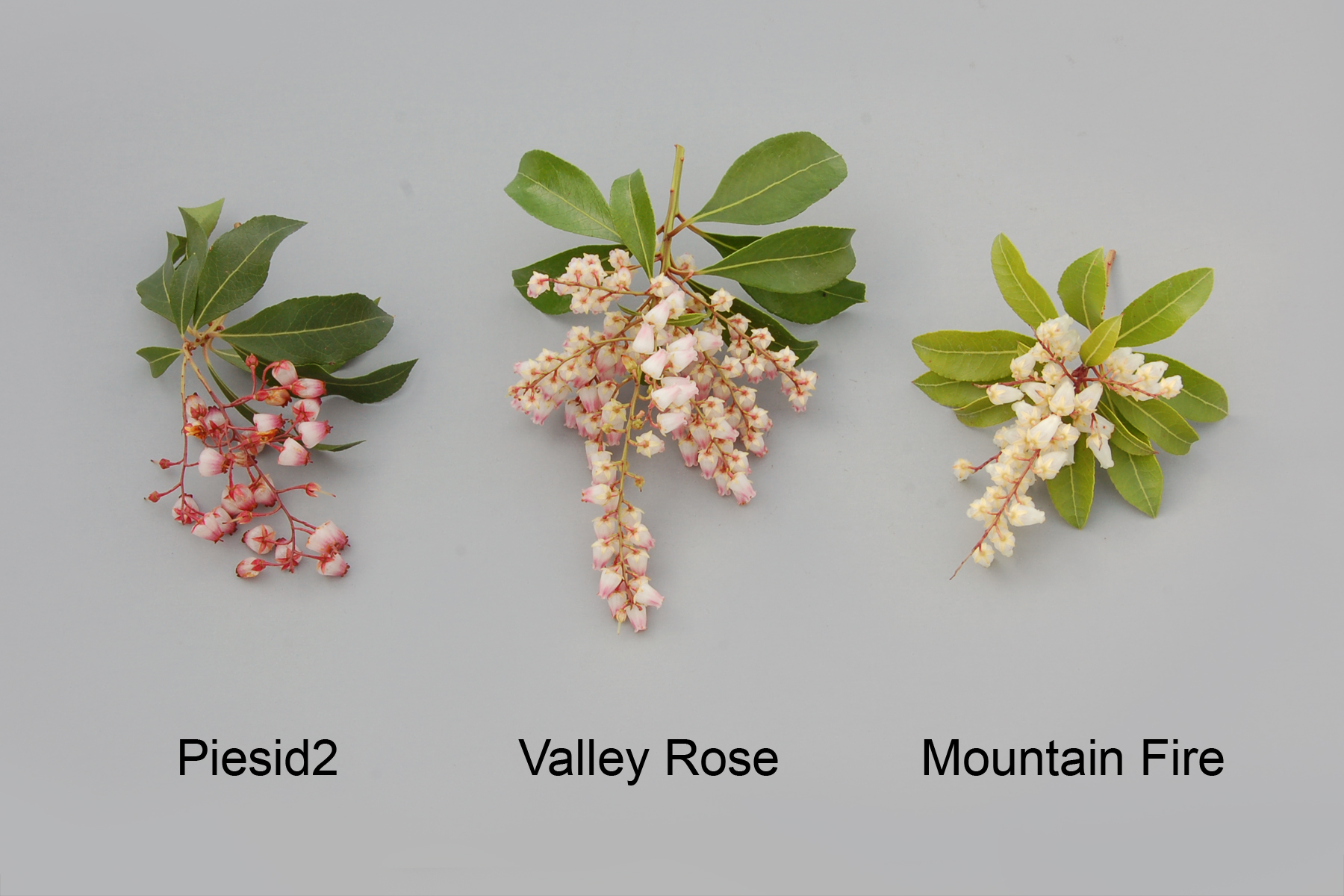Piesid2
| Denomination: | 'Piesid2' |
|---|---|
| Botanical Name: | Pieris japonica |
| Applicant/Holder: |
Sidhu, Gurjit 9623 Sylvester Road Mission, British Columbia V2V 7K6 Canada |
| Breeder: |
Gurjit Sidhu, Mission, British Columbia |
| Application Date: | 2021-04-15 |
| Provisional Protection:: | 2021-04-15 |
| Application Number: | 21-10460 |
| Grant of Rights Date: | 2023-05-29 |
| Certificate Number: | 6830 |
| Grant of Rights Termination Date: | 2043-05-29 |
Variety Description
Varieties used for comparison: 'Valley Rose' and 'Mountain Fire'
Summary: The natural plant height of 'Piesid2' is shorter than that of 'Valley Rose'. The plants of 'Piesid2' are narrower than those of 'Valley Rose' and wider than those of 'Mountain Fire'. The leaf blade of 'Piesid2' is larger than that of both reference varieties. The pedicel of 'Piesid2' is longer than that of both reference varieties. The inner side of the sepal of 'Piesid2' is red pink over a light yellow brown ground colour whereas that of both reference varieties is light yellow. The arrangement of the corolla lobes of 'Piesid2' is free whereas for 'Mountain Fire' they are overlapping. The corolla of 'Piesid2' is wider than that of both reference varieties. The secondary colour of the inner side of the corolla lobe of 'Piesid2' is dark blue pink and light red pink at the apex with dark brown along the margin whereas that of 'Valley Rose' has medium blue pink to light blue pink at the apex and that of 'Mountain Fire' has no secondary colours present.
Description:
PLANT: shrub type, globose shape, upright to bushy growth habit, medium to dense branching
NEW SHOOT: yellow green in spring, green in summer
STEM: light brown to greyed orange mature wood, medium thickness, glabrous pubescence, round in cross section, smooth to slightly rough bark, weakly fissured mature bark, no glaucosity, no lenticels, no thorns
LEAF: simple type, spiral arrangement on the stem
LEAF BLADE: elliptic, acute to acuminate apex, cuneate base, entire with shallow crenate to serrate incisions along the distal half, no lobing, very weak rugosity, absent or very weak waviness of margin
LEAF BLADE (UPPER SIDE): absent or very sparse pubescence, dark green with light green midrib mid-season, no variegation
LEAF BLADE (LOWER SIDE): absent or very sparse pubescence, medium green with whitish green midrib mid-season, absent or very weak intensity of anthocyanin colouration on veins
PETIOLE: present, weak intensity of anthocyanin colouration
SEPAL: lanceolate, acute apex, weak recurvature of tip, entire margin, medium density of pubescence on inner side, dark stipitate glands present on outer side, red pink (RHS 53C) over light yellow brown (close to RHS 162C) ground colour on inner side
INFLORESCENCE: raceme type, density ranging from medium to dense
COROLLA: free arrangement of lobes, absent or very sparse pubescence on inner and outer side
COROLLA LOBE: mainly white (RHS NN155B) on outer side, dark blue pink (redder than RHS 72C) and light red pink (RHS 50D) at apex on outer side, dark brown (RHS N77A) along margin on outer side, dentate apex
Origin & Breeding History: 'Piesid2' originated as a naturally occurring branch mutation that was discovered and developed by the breeder in Mission, British Columbia, in the summer of 2016. The mutation was discovered on a plant of the Pieris japonica variety 'Valley Rose' growing in a block of 1 gallon containers. The new variety was selected as a single unique seedling based on the new leaf colour. Asexual reproduction of 'Piesid2' was first conducted by tissue culture in the spring of 2018, in Mission, British Columbia.
Tests & Trials: The comparative trial for 'Piesid2' was conducted in a polyhouse during the spring of 2021, at BioFlora Inc., in St. Thomas, Ontario. The trial included 10 shrubs each of the candidate and reference varieties. All shrubs were grown from rooted cuttings and transplanted into containers in the early spring of 2021. Observations and measurements were taken from 10 plants or 10 parts of plants of each variety on May 10, 2021 (for flowers) and June 23, 2021 (for summer plant and leaf characteristics). All colour determinations were made using the 2015 Royal Horticultural Society (RHS) Colour Chart.
Comparison tables for 'Piesid2' with reference varieties 'Valley Rose' and 'Mountain Fire'
Natural plant height (cm)
| 'Piesid2' | 'Valley Rose' | 'Mountain Fire' | |
|---|---|---|---|
| mean | 39.2 | 46.1 | 35.5 |
| std. deviation | 2.94 | 6.94 | 6.25 |
Plant width (cm)
| 'Piesid2' | 'Valley Rose' | 'Mountain Fire' | |
|---|---|---|---|
| mean | 52.7 | 66.8 | 44.9 |
| std. deviation | 2.31 | 3.37 | 5.76 |
Leaf blade length (cm)
| 'Piesid2' | 'Valley Rose' | 'Mountain Fire' | |
|---|---|---|---|
| mean | 9.0 | 6.7 | 6.3 |
| std. deviation | 0.43 | 0.75 | 0.62 |
Leaf blade width (cm)
| 'Piesid2' | 'Valley Rose' | 'Mountain Fire' | |
|---|---|---|---|
| mean | 3.0 | 2.3 | 2.6 |
| std. deviation | 0.38 | 0.19 | 0.28 |
Pedicel length (mm)
| 'Piesid2' | 'Valley Rose' | 'Mountain Fire' | |
|---|---|---|---|
| mean | 8.4 | 5.1 | 5.8 |
| std. deviation | 0.84 | 0.74 | 0.83 |
Colour of sepal (RHS)
| 'Piesid2' | 'Valley Rose' | 'Mountain Fire' | |
|---|---|---|---|
| inner side | 53C with ground colour close to 162C | 10C | 10D |
Corolla width (mm)
| 'Piesid2' | 'Valley Rose' | 'Mountain Fire' | |
|---|---|---|---|
| mean | 7.6 | 6.3 | 5.7 |
| std. deviation | 0.9 | 0.5 | 0.4 |
Colour of inner side of corolla (RHS)
| 'Piesid2' | 'Valley Rose' | 'Mountain Fire' | |
|---|---|---|---|
| secondary | redder than 72C, as dark as 50D and N77A | 62B-C | N/A |
Click on image for larger view

Japanese Andromeda: 'Piesid2' (left) with reference varieties 'Valley Rose' (centre) and 'Mountain Fire' (right)
Click on image for larger view

Japanese Andromeda: 'Piesid2' (left) with reference varieties 'Valley Rose' (centre) and 'Mountain Fire' (right)
Click on image for larger view

Japanese Andromeda: 'Piesid2' (left) with reference varieties 'Valley Rose' (centre) and 'Mountain Fire' (right)
- Date modified: